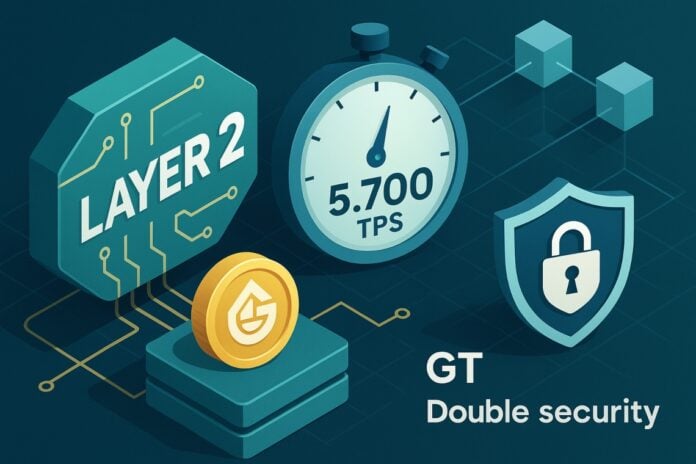Numbers in hand: Gate introduces a Layer 2 network with a declared throughput of 5,700 TPS, blocks with a block time of 1 second, and GT as the exclusive gas token.
According to an analysis published by CoinDesk, by September 2025, over 180 million GT have been burned, equivalent to about 60% of the initial supply.
These factors directly impact costs, latency, and the security profile of the ecosystem; however, it remains crucial to verify the testing methodology that led to the declared throughput values.
According to data collected from public reports and industry analysis, the peak throughput metrics were obtained under controlled conditions and may vary in production.
Analysts also note that, to confirm the repeatability of the 5,700 TPS, independent benchmarks and details on the setup (transaction type, block size, network topology, hardware) are needed.
Summary
What is Gate Layer 2 and why is it relevant
Gate Layer adopts an architecture inspired by the OP Stack – the rollup framework of Optimism – to move a large part of the computation off-chain. Settlement occurs on GateChain, instead of on Ethereum, giving the network an autonomous and distinct security model.
The network is EVM-compatible: developers can use established tools like MetaMask or Remix and migrate existing DApps with minimal changes. In this context, the goal for the user is clear: faster transactions and lower fees.
Key Specifications and Numbers
Full EVM Compatibility
The EVM environment reduces deployment barriers and speeds up the migration of already tested smart contracts, simplifying testing, auditing, and the integration of standard Ethereum ecosystem tooling. For an overview of the basic concepts of Layer 2, see our guide on Layer 2.
Throughput and finality
- 5,700 TPS declared under optimal conditions.
- Block time: 1 second for near-instant interactions.
- The purposes and exit timing on L1 depend on the settlement process on GateChain.
Metric note: the values are communicated by Gate; the complete testing methodology (type of transaction, block size, network, and hardware) has not been disclosed at the time of writing. For further technical details on Layer 2 efficiency and performance, delve into our scalability guide.
Transaction Costs
- Gate estimate: less than 30 USD for 1 million transfers on the network.
- Indicative comparisons (under the same stated conditions): on Base ~ 700 USD, on BSC ~ 2,000 USD, and on Solana ~ 1,000 USD.
These figures are indicative; in the absence of a public methodology and third-party tests, comparisons remain indicative. For operational decisions, it is advisable to conduct local tests with real costs and loads.
Double Protection Security
Security is based on settlement on GateChain and staking that uses GT, reducing single points of failure and distributing risk.
It should be noted that the model differs from that of rollups that inherit Ethereum’s security, therefore the trust assumptions and threats may not coincide with those of Layer 2 on Ethereum.
To delve deeper into the different Layer 2 security models, check out the recent news and updates on blockchain scalability.
Ecosystem: products and use cases
- Perp: platform for high-liquidity perpetuals, with an efficient matching engine and cross-chain support.
- Gate Fun: no-code platform to create low-cost tokens with initial liquidity.
- Meme Go: hub for real-time monitoring and low-latency trading of meme tokens.
The stated goal is to cover the entire user cycle, from development to trading, with attention to volumes and liquidity over time.
GT Economy: gas, burn, and governance
GT as an exclusive gas token
All on-chain activities on Gate Layer — including transfers, smart contract deployments, NFT mints, and bridges — require GT as a gas token. The increase in usage translates into a higher demand for fees in GT, strengthening the role of the token within the ecosystem.
Deflationary Mechanisms
- Scheduled burns: executed periodically based on predetermined allotments.
- Burn on-chain: according to the EIP-1559 model, where a portion of the fees is automatically burned.
- As of September 24, 2025: 180,555,112 GT have been burned, equivalent to approximately 60.18% of the initial supply of 300 million (data published by industry sources and reported in the media).
The dual mechanism aims to increase the scarcity of the token in the long term. That said, greater transparency is still needed on the contracts involved, burn rules, and verifiable reports, ideally published on verifiable on-chain repos or dashboards.
How to use Gate Layer
- Connect an EVM wallet (e.g., MetaMask) and add the Gate Layer network.
- Transfer GT to cover the gas fees.
- Interact with migrated or native DApps, always verifying the contract address and permissions.
Standard tools (such as Hardhat and Remix) and compatible RPCs are available for developers. Indeed, it is advisable to conduct tests in dedicated environments before deploying to production.
Scalability and Interoperability
Layer 2 solutions shift the load from the mainnet, increasing its capacity and reducing costs, thus making apps more accessible and scalable. For operational aspects and best practices, refer to our scalability guide.
Gate Layer integrates the LayerZero protocol to enable cross-chain transfers between Ethereum, BSC, Polygon, and other networks. While expanding use cases, this approach involves typical bridge risks, such as dependencies on oracles, relayer security, and differing finalities between networks.
Conclusions
Gate Layer offers high performance, low fees, and a dual protection security model, with GT at the center of the network’s economy.
The burn mechanisms, already active and documented in industry media until September 2025, help increase the token’s scarcity and align the chain’s use with the growing demand for GT.
For a comprehensive evaluation, verifiable data will be necessary: independent benchmarks, public audits, and clear testing criteria, which allow for a rigorous measurement of the impact on adoption, real costs, and operational risk.


